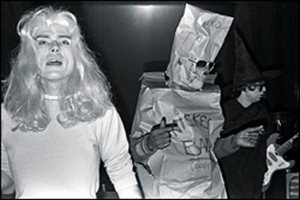Book Giveaway — Ravi Mangla’s “Understudies”
Comment in the thread here for a chance to win a copy of Ravi Mangla’s Understudies:
“a deadpan, sharply-observed novel about the sadness pervading a contemporary world fixated on simulation and celebrity. Like so much of America, the small town where Understudies takes place exists under a mediated, televisual spell. Everyone’s chasing fame, desperate for that particular brand of social capital endemic to the internet age.” – Michael Jauchen (3 AM)
A winner Ravi chooses from the comments will receive:
so, comment away (& I’ll notify the winner in a few days)
2013 Holiday Shopping Guide: Nonfiction Recommendations

I did this last year and some folks seemed to dig it; plus, I enjoy the hell out of making lists and reading lists like these so I’m doing it again this year.
Even granting that these represent my own interests (film, philosophy, art, literature, etc.) and therefore omit plenty of titles I’m sure were great but fall outside my purview, with so many badass nonfiction books published this year it was nearly impossible to select only twenty titles. Tough cuts had to be made.
So my thinking behind this list was to present you with books that might not already be on your radar. Which is to say, a brilliant book such as Scott McClanahan’s Crapalachia: A Biography of Place, or Rebecca Solnit’s The Faraway Nearby
, or Jamie Iredell’s I Was a Fat Drunk Catholic School Insomniac
, for instance, aren’t on this list because I figure you’ve already read them or are at least aware that they are completely awesome and that you need them.
Without further blah blah, you can expect two more of these in the coming days, one for fiction and one for poetry.
If you’re like me and haven’t even begun shopping yet, hopefully this list will help you find something for someone. Oh and for those who care, my click-throughs use my Amazon Affiliate number…the pennies that come back to me when you click on the titles go toward diapers and baby soap for my four month old son.
CENTERPIECE by Daniel S. Muehlmeier
 CENTERPIECE
CENTERPIECE
by Daniel Muehlmeier/Lee Mothes
Warm Wax Inc., 1991
2 players / 30 minutes / $19.99 from eBay
CENTERPIECE is a board game designed by Daniel S. Muehlmeier, self-described “unlocker of secrets,” with art by Lee Mothes. It was taken off a Goa’uld mother ship.
You won’t find CENTERPIECE in the Toys & Games section of your local Barnes & Noble. The game, originally published in 1991, is a notoriously tough sell. “I do well in the twenty-dollar range,” said the author in his recent Kickstarter campaign, which managed to raise only $615 of funds from 23 backers. “I keep a few game boxes in my cars back-window. Creating sales proved tough for me.”
“One restaurant placed five games. Near where people pay. All five disappeared, I never even restock them. Example of really bad-marketing skills. Yet I’m really looking forward, to direct mail to customers.” Following the close of the Kickstarter, the game is now being listed on eBay under the heading “tradition game, toys and Hobbies.” Yet this is just a stepping stone for Muehlmeier, who would eventually like to see his game displayed in a contemporary art museum.
Nor is this a delusionary ambition. Bad-marketing skills aside, Muehlmeier’s creation intrigues; in fact, it’s best approached from the vantage point of art (as opposed to game) criticism. Even taken as a game, CENTERPIECE is an answering shot to the pet theory that the whole of a game’s value rests within its mechanical core, for which the superficial elements of theme and appearance serve as mere window dressing.

CENTERPIECE‘s mechanisms of play are invitingly familiar. In fact, CENTERPIECE could accurately be called a pastiche of several games known to all American children: Monopoly, Parcheesi, Chutes and Ladders. Pastiche in both senses of the word, since CENTERPIECE‘s core mechanisms walk a tricky line between quotidian simplicity and schizophrenic montage, made no more easily reconciled by the often indecipherable rules, which read like an antique riddle. “Players are encouraged to use common sense,” the single-leaf rules advise. “For example, if both players are sent to the Bird Cage; because a player rolled a two, while visiting the Honey Jar space. The player who rolled snake-eyes would roll for doubles first. Both player would stay for three turns, unless doubles were rolled.”
Once mastered, CENTERPIECE is an almost fully luck-driven affair, a roll-and-move game destined to be despised by the modern board game community, who have become spoiled by worker placement, economic engines, asymmetric player roles, and all the other innovations the last two decades have brought to the medium (remember, CENTERPIECE is a time capsule from the early ’90s, although aesthetically, it hearkens to an even earlier era). Yet the game’s “superficial” elements are not to be discounted, for they create a metaphorical frame or structure as the game plays out, turning a simple reimagining of Monopoly into something that far exceeds the sum of its parts.

As if to embody this very statement, the first bread crumb along CENTERPIECE‘s allegorical trail is the fact that the game’s box, colorfully illustrated by artist Lee Mothes, is also central—both literally and figuratively—to its gameplay. Once the board has been unfolded, the box top is placed at its center, a mechanically unimportant gesture that receives special emphasis in the game rules—and is hammered home with every turn, as the dice pounding off of its cardboard surface speak testimony to its substance (that the dice must be rolled off of the box top is another apparently superficial but ritualistically significant gesture). As the eponymous centerpiece, this raised rectangle of cardboard naturally draws the eye—it is the only spot of color in an otherwise black-and-white composition—while hiding the game’s deepest secrets. A display of puzzle pieces nestled beneath track the players’ scores, and it is to Muehlmeier’s infinite credit that he keeps this indispensible information hidden away until the moment that the box is lifted, a moment that always coincides with a change in the data under scrutiny. It is the uncertainty principle actualized.
December 4th, 2013 / 12:00 pm
Favorite Books Read During 2013
December already?? A brief & informal list of some of my favorite books read during the year 2013 (not necessarily published in 2013).
***
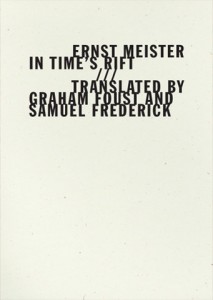 In Time’s Rift by Ernst Meister (Wave Books, 2012)
In Time’s Rift by Ernst Meister (Wave Books, 2012)
Translated by Graham Foust and Samuel Frederick
This,
the familiar,
will eternally be
an unknown to you;
anyway, you’re no longer
known to yourself.
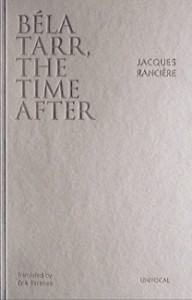 Béla Tarr, The Time After by Jacques Rancière (Univocal Publishing, 2013)
Béla Tarr, The Time After by Jacques Rancière (Univocal Publishing, 2013)
Translated by Erik Beranek
“We cannot identify ourselves with their feelings. But we enter into something more essential, into the very duration at the heart of which things penetrate and affect them, the suffering of repetition, the sense of another life, the dignity assumed in order to pursue the dream of this other life, and to bear the deception of this dream.”
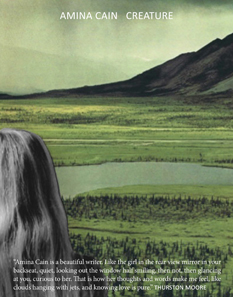 Creature by Amina Cain (Dorothy, A Publishing Project, 2013)
Creature by Amina Cain (Dorothy, A Publishing Project, 2013)
“When I got home, my partner was eating an egg. This is what he does when I’m not around. He also eats fish. I was harsh to him, but without speaking. I expressed myself through the violent putting away of a pan. Later I saw on his lap and dreamed about the future. This was together alone.”
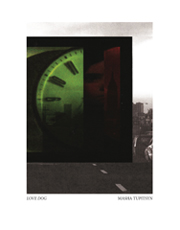 Love Dog by Masha Tupitsyn (Penny-Ante Editions, 2013)
Love Dog by Masha Tupitsyn (Penny-Ante Editions, 2013)
“My ears have been hearing things, things which aren’t even words, or messages, while my eyes, along with everyone else’s, are forever telling me that nothing is here. That nothing is happening. It is the difference between inward and outward. Between me and everyone else.”
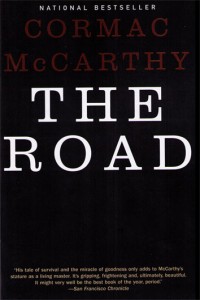 The Road by Cormac McCarthy (Vintage Books, 2007)
The Road by Cormac McCarthy (Vintage Books, 2007)
“He walked out in the gray light and stood and he saw for a brief moment the absolute truth of the world. The cold relentless circling of the intestate earth. Darkness implacable. The blind dogs of the sun in their running. The crushing black vacuum of the universe. And somewhere two hunted animals trembling like ground-foxes in their cover. Borrowed time and borrowed world and borrowed eyes with which to sorrow it.”
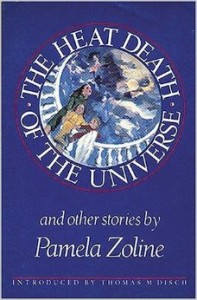 The Heat Death of the Universe and Other Stories by Pamela Zoline (Mcpherson & Co, 1988)
The Heat Death of the Universe and Other Stories by Pamela Zoline (Mcpherson & Co, 1988)
“2. Imagine a pale blue sky, almost green, with clouds only at the rims. The earth rolls and the sun appears to mount, mountains erode, fruits decay, the Foraminifera adds another chamber to its shell, babies’ fingernails grow as does the hair of the dead in their graves, and in egg timers the sands fall and the eggs cook on.”
 The Memoirs of JonBenet by Kathy Acker by Michael du Plessis (Les Figues Press, 2012)
The Memoirs of JonBenet by Kathy Acker by Michael du Plessis (Les Figues Press, 2012)
I’m afraid we’re inventing something that isn’t there.
Why is sex with you another blank?
Waiting, as you consider it, is fine but there comes a moment when the conditions you impose outweigh any present emotions. “I can’t be with you until…” translates into “I can’t be with you until caution becomes indifference.” Yes, as you say over and over again, you’ve made me feel again; truly, I do feel again, enough to be able to tell you that I’m only telling myself that I feel with you.
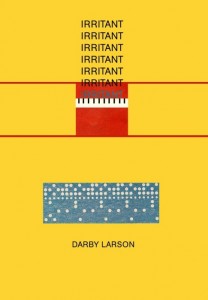 Irritant by Darby Larson (Blue Square Press, 2013)
Irritant by Darby Larson (Blue Square Press, 2013)
“In something of red lived an irritant. Safe from the blue from the irr. And this truck went in it. Safe. Something of red in it back to the blue to the red. This truck and something extra. Listen. The nearby something extras in front of the truck. The man in front of the truck trampled from front to back safe from the blue. And all this while the man scooped shovels of dirt and trampled from front to back front to back.”
 Anna Patova Crosses a Bridge by Renee Gladman (Dorothy, A Publishing Project, 2013)
Anna Patova Crosses a Bridge by Renee Gladman (Dorothy, A Publishing Project, 2013)
For one second, I spoke “sentence,” which confused her, since all this time I’d been saying “paragraphs.” It was a moment of our mouths missing one another. Her mouth was emitting sound. She seemed to be calling my name, breathing heavily, she seemed to put her words inside me. “Writing my frightening paragraphs,” I said, involuntarily.
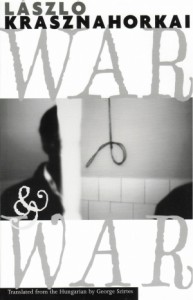 War and War by László Krasznahorkai (New Directions, 2006)
War and War by László Krasznahorkai (New Directions, 2006)
Translated by George Szirtes
“I no longer care if I die, said Korin, then, after a long silence, pointed to the nearby flooded quarry: Are those swans?”
 Music & Literature Issue 2: Krasznahorkai / Tarr / Neumann (Spring 2013)
Music & Literature Issue 2: Krasznahorkai / Tarr / Neumann (Spring 2013)
From “About a Photographer” by Lászlo Krasznahorkai (Translated by George Szirtes):
“Condemned to look, yet at the same time to be deprived of sight, we are in a complex pitiless trap, a double cage, to the recognition of which—though it cages us all—fate condemns confusingly few. In any case those who do suffer the agonizing moment of recognition could easily be consumed by an all-but fatal melancholy, so it’s no wonder they try to struggle free, their first recourse on their dire necessity being the thought of some device.”
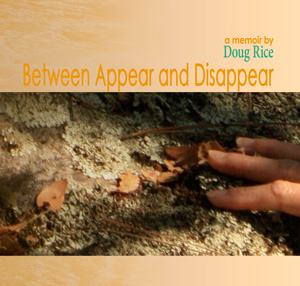 Between Appear and Disappear by Doug Rice (Jaded Ibis Press, 2013)
Between Appear and Disappear by Doug Rice (Jaded Ibis Press, 2013)
“I want to find a sentence that in the making becomes a resurrection. Our skin marked by the remains of language from childhood dreams near the river. The Allegheny. The Monongahela. The Ohio. This trinity of cold rivers that demand that we never forget to forgive.”
 Murder by Danielle Collobert (Litmus Press, 2013)
Murder by Danielle Collobert (Litmus Press, 2013)
Translated by Nathanaël
“It’s strange this encounter with the internal eye, behind the keyhole, that sees, and finds the external eye, caught in flagrante delicto of vision, curiosity, uncertainty. The one that looks out, to see outside itself, what is happening in the world, perhaps, or inside itself, this eye, doesn’t know whether it’s looking into the emptiness, into the air, into the other, or into a distance landscape, which it brought to like, like a memory, a wanted decor, chosen, an elemental power, that could be the background of its life.”
Thanksgiving Morning, 2013

We had some plans but an unexpected medical procedure canceled those plans. READ MORE >
No Thanks: A Simple Wish for the Ends of Alt Lit
Last week I watched Nathan Staplegun eat salted peanuts on spreecast. What started off as Nathan eating salted peanuts soon turned into Nathan asking his roommates or friends (and thus turning the computer camera in their direction) what they were preparing in the kitchen, and quickly became a spreecast showing one of Nathan’s online friends playing guitar. On the surface, Nathan Staplegun eating salted peanuts on television (that’s what platforms such as spreecast are: do-it-yourself TV) would seem like a snooze, a no-brainer, an excuse to read more books. But, what Nathan did was really great. He put on TV a thing that he would have done anyway and by doing it on TV turned the act of eating salted peanuts into something else: an event, perhaps.
I love to tell the story of Glenn O’Brien’s TV Party. In 1978, Glenn O’Brien and friends (and his friends were people like Jean-Michel Basquiat, Amos Poe, Deborah Harry, Walter Steding, Chris Stein) got together and decided to take advantage of public access cable television in New York City. The format was simple: hang out with friends, get high (one episode had Fab Five Freddy in costume teaching viewers how to roll perfect joints), have your friends play music, and talk to people (viewers called in live while the show was on air and used their short time to make death threats and complain about how shitty the show was). By television’s standards, the TV Party shows were shitty, but they were fun to watch. And, in their own way, became increasingly popular (special guests included David Byrne, Klaus Nomi, and Mick Jones of The Clash) and influential (in one of his early top ten lists David Letterman cited TV Party as an influence). Art and everyday life will never be separate things; although, the art marketers sure seem to want us to believe that they are. Friends get together, record each other doing silly things, or someone we hardly know broadcasts himself washing dishes or whatever, and art’s possibility is renewed, if not, realized.
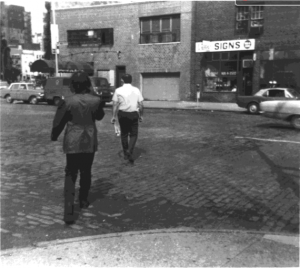
The word ‘creepy’ has not always had negative connotations. Vito Acconci follows people around New York City as part of his month-long performance ‘Following Piece’.
I have been kicking around the idea of starting a series of posts in which I cruise my facebook friends’ facebook photos and post the ones I like as part of ‘Creeper: Favorite Facebook Photos of My Facebook Friends’. The word ‘creep’ (and its variations) has not always had negative connotations. When Radiohead hit the pop charts in 1992 with their debut single “Creep” the song seemed like a strange, wonderful call to embrace the pathos of a loser, a lost subcultural weirdo whose dreams and desires are too much for himself and the world. Much like Beck’s “Loser” the song seemed to reinvigorate a long-standing yet dangerous tradition in the arts: the elevation of the low, the loser, the outsider, the emotional clown, to the status of cultural barometer, of artist. Long-standing because American cultural producers had carefully exploited this type for profit since the early days of white rock ‘n’ roll (Elvis Presley) and the first teen films (Rebel Without A Cause). Dangerous because sometimes people actually believed in these characterizations enough to begin to act like rebels, not satisfied with merely listening to them on the radio or watching them at the movies.
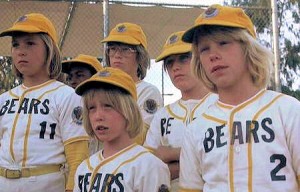
It’s not Dennis Cooper’s male escorts of the month. It’s The Bad News Bears (1976), who demonstrated that life sometimes artfully happens when a bunch of losers get together and push the game to its limits.
In 1969, Vito Acconci made art by simply following people around New York City. Acconci spotted someone on the street and followed them until they disappeared into a place he couldn’t, or didn’t, want to go. Acconci’s performance lasted almost a month. He’d get up, go outside, spot someone, and follow. Most spreecasts, for better or for worse, go on way too long. But, so does hanging out with one’s friends. At some point, you want to be by yourself or hang out with someone else. With the advent of the spreecast you can hang out with people you know or don’t know or want to know simply by joining in. It’s the logic of the club but not as restrictive. Of course, hanging out on spreecasts may never beat the intimacy of being in the same room with a friend or a loved one or turning it all off and reading a book. But I’ve known a lot of people who got all the companionship they needed by simply watching episodes of Breaking Bad or whatever–and apparently, according to some, you can be plugged in and still experience solitude.
This isn’t a plug for spreecast, who I could give two fucks about. It is a plug for a kind of art that denies the art market and realizes itself in everyday life. One doesn’t need an important architectural group, a big publisher, and a major museum to support an effort to follow and document people in your neighbor (although Acconci had all of those). One does need ideas. I was talking to Elizabeth Emily D’Agostino in her car about art. We were parked outside my apartment–a perfect venue to discuss anything. Our conversation shifted to cultural amnesia, an easy target. In our desperate efforts to predict the future I described for her a story written by Tao Lin and boldly proclaimed that this was Lin’s crowning moment and that history would look at this moment as an opportunity lost. The story is simple enough:
when i was five
i went fishing with my family
my dad caught a turtle
my mom caught a snapper
my brother caught a crab
i caught a whale
that night we ate crab
the next night we ate turtle
the next night we ate snapper
the next night we ate whale [. . .]
The last line of the story is repeated almost endlessly or as long as the writer/reader can endure it. Although, I have read a version of it where it ends rather abruptly. For a video account of its hilarity, you can listen to Tao read it here.
Why an opportunity lost? Because when an artist with the talent of Tao Lin comes along he seems to come with a two-pronged fork capable of reflecting the zeigeist back to us and/or breaking the hold the zeigeist has on our attitudes, desires, fashions, discourses, etc. In the post-Warholian world in which we live contemporary artists have made it clear that they are more interested in and perhaps more capable of showing us who they are (i.e. reflecting the ‘zeigeist’ back to us) than breaking the mirrors that bind us to a social-medial and political-economic worldview that reinforces the notion that ‘we’re fucked.’
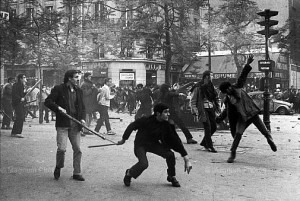
May 1968, France. Today, the attitudes and aspirations of the ‘me generation’ of the 1970s have resurfaced in the attitudes and aspirations of millennial artists.
We are fucked. In Sheila Heti’s novel, How Should a Person Be?, someone comes up with an idea for an ugly painting competition. I say ‘someone’ because not even Sheila, our narrator, knows who came up with the idea. The idea of making the ugliest painting is more difficult than you’d think. Relationships are ended, lives are changed. During the height of the national crisis that was punk rock in England in the 1970s, a roadie for The Who dismissed the movement as a mere ‘revolt of the uglies.’ I mean, imagine calling a bunch of teenagers parading their misfortunes, economic hardships, childhood traumas, bad skin, social awkwardnesses, and fashion made of actual garbage found in the street as revolting or, worse, ugly? It is with these two sentiments in mind–a conceptual call to ugliness in the name of something else (Heti) and its celebration as an insult (punks)–that I invoke the writers and artists of the alt lit movement, a movement that has come to signify everything that’s right and wrong about everything that’s fast, cheap, and out-of-control in the arts today. Perhaps the time has come to break the mirrors that bind us to our own little personal victories (i.e. ‘I’m internet famous’) and begin the more fun and difficult work of smashing those fucking mirrors so that we–and the big, bad world–may see ourselves again, as something else, something more, something seemingly uglier and thus, perhaps, more beautiful. Of course, you could choose to ignore me (I’m used to it, really)–your career path probably profiting more from it–than listen to me whisper to you, from the salted peanut gallery.
@janeysmithkills
kottonkandyklouds.tumblr.com
If Not Notley Then Whatley Elseley?
 I’m Cassandra Gillig and I can’t believe that it’s Not Illegal to buy this new chapbook by Alice Notley. It’s not even imprudent or tacky, it’s just a good thing that is good. I did it two times and am waiting for the results !!!The Results Are In!!! just kidding they’re not I only ordered it seven minutes ago.
I’m Cassandra Gillig and I can’t believe that it’s Not Illegal to buy this new chapbook by Alice Notley. It’s not even imprudent or tacky, it’s just a good thing that is good. I did it two times and am waiting for the results !!!The Results Are In!!! just kidding they’re not I only ordered it seven minutes ago.
No one has gone to the bother of describing the book I have no idea how many pages it is this could be not even a book IS THIS ACTUALLY A BOOK WHAT THE FUCK DID I JUST BUY I AM CALLING THE POLICE if Not A Book then What is It I think probably It is Good do you need more than that? You do? OK it is this big: 5 1/4″ x 7″. I don’t remember if quotes mean inches or feet. Is this a SEVEN FOOT TALL BOOK? This is just how it has to be when you need it to happen. I still don’t know if this is a book or not.
Back in the late seventies or early eighties (what) Robert Creeley said of Alice Notley, “She’s the Boss.” There was even another Boss at that time: Bruce Springsteen. Alice was just that good; she was better than thunder road or hungry heart–much better. I can’t believe I know people who have decided to not buy this chapbook I think it’s just rude. You’re sitting and not buying how should I feel about it if not personally offended. I am a little sour you have not bought it why are you still reading this and not having this page open to order and buy this chapbook. This chapbook was made by The Catenary Press which seems like a reliable source of chapbooks. It seems like–generally–people give them money and then they give those people chapbooks. It’s so crazy this fucked up capitalist economy where you can buy things or even buy works of art. What the fuck I miss the good old days when carriage rides were all that moved me.
I can’t review it because I haven’t read it but I can tell you that without Alice Notley’s work I would be probably engaged to be married to The Wrong Guy. God what would I have done with The Wrong Guy? Would we have even been able to Go Out? There’s a Wrong Guy on almost every corner of every street in every America. I bet none of them would buy this chapbook. Oh god what did I almost do??? I am a marked woman through and through.
NEKKID & NEUROTIC
Interesting piece on the Romantik of the 70s. Reference-heavy, but mostly familiar texts & media, I think.
Also, click on the second footnote’s link to read the Eno thing: Naked and Neurotic. It’s kinda wild/ weird: “The only time my feet aren’t cold is when I make love, which I do all the time. I only make love to keep my feet warm.”
Some Unscientific Thoughts on Depression
 Depression is a different animal entirely. For the depressed person, the bulk of precedents—be they figures one admires that also dealt with depression, or works that seem to encapsulate the modern understanding of this phenomenon—have occurred in the last hundred years or so; and although it’s not difficult to develop a strong empathy for depressed figures like Lincoln, Nietzsche, or Albrecht Dürer, the lines of history tend to blur and complicate personal afflictions to such an extent that for every book that might exist exploring the various miserable icons we’ve had, there are hundreds documenting their triumphs and love affairs to bury these desired texts neath the fantastical self help mega library.
Depression is a different animal entirely. For the depressed person, the bulk of precedents—be they figures one admires that also dealt with depression, or works that seem to encapsulate the modern understanding of this phenomenon—have occurred in the last hundred years or so; and although it’s not difficult to develop a strong empathy for depressed figures like Lincoln, Nietzsche, or Albrecht Dürer, the lines of history tend to blur and complicate personal afflictions to such an extent that for every book that might exist exploring the various miserable icons we’ve had, there are hundreds documenting their triumphs and love affairs to bury these desired texts neath the fantastical self help mega library.
TWO FEASIBLE PRECEDENTS

The first, and perhaps most obvious best friend to the depressed person post-1995 who happens to enjoy literature, is probably David Foster Wallace. Before him, the aforesaid lines of history tend to make the case of Sylvia Plath or Van Gogh fairly cut and dry, to the extent that Plath’s life might be seen as her sitting down at a desk and writing some beautiful works, then immediately falling into such a vat of misery that she stuck her head in an oven, the same model largely applies for Van Gogh except it’s paint, with a bit of ear-severing—though not as drastic as history has made it out to be—and the man shooting himself in the heart twice before walking back into the city undead, only to die two days later. With Wallace, however, we have an accomplished intellect who came to suffer severely from depression after the road had begun to be mapped out for him. Already well into his college career—and of course you can argue that his depressive tendency existed before this, but as I understand it this was when Wallace really came to blows with the malady—he seemed destined for literary accomplishment before being thrust into the void of chemical dissonance and thus forced to consider contemporary (this is important) means of salving the indiscernible wound. And, luckily for us, he managed to write some of the most fascinating fiction and non- about the subject to happen in years. This is a curious thing to me. For all the talk I’ve heard of Wallace’s mastery over the contemporary form, or something, I seldom hear discussed his great command over the subject of fucking misery, modern boredom, or complete and total suicidal ideation. I guess it’s hinted at much of the time, but as far as I’m concerned the guy is close to our American Foucault as it relates to the depressive animal, with “Good Old Neon” or the Kate Gompert portions of Infinite Jest—perhaps my favorite in the whole book, weirdly enough—or Wallace’s nonfiction and more—the subject tends to permeate everything as far as I’ve gathered—what we have in Wallace is a guide for the solving of the plight described by Scott Fitzgerald years prior to this, that “the natural state of the sentient adult is a qualified unhappiness.” For more on this I highly recommend Postitbreakup’s fairly recent post for Dennis Cooper’s blog, “David Foster Wallace’s triptych on depression.” READ MORE >



